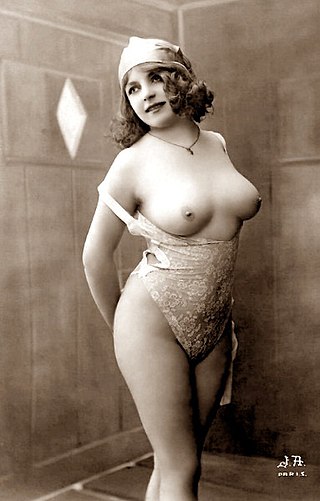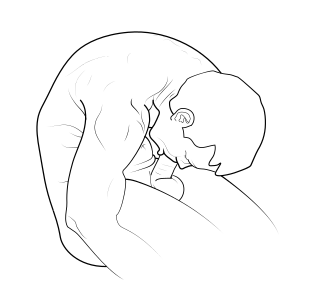
Erotica is literature or art that deals substantively with subject matter that is erotic, sexually stimulating or sexually arousing. Some critics regard pornography as a type of erotica, but many consider it to be different. Erotic art may use any artistic form to depict erotic content, including painting, sculpture, drama, film or music. Erotic literature and erotic photography have become genres in their own right. Erotica also exists in a number of subgenres including gay, lesbian, women's, bondage, monster and tentacle erotica.

Fellatio is an oral sex act involving a person stimulating the penis of another by using the mouth. Oral stimulation of the scrotum may also be termed fellatio, or colloquially as teabagging.

Erotic massage is the use of massage techniques by one person on another person's erogenous zones for their sexual pleasure. The process may achieve or enhance the recipient's sexual excitation or arousal and sometimes achieve orgasm. The person providing the massage is called a masseur (male) or masseuse (female). Massages have been used for medical purposes for a very long time, and their use for erotic purposes also has a long history. In the case of women, the two focal areas are the breasts and pubis, while in case of men, the focal area is the male genitals, the anus, and the prostate. When the massage is of a partner's genitals, the act is usually referred to as a handjob for penises and fingering for vulvas.

Autofellatio is a form of masturbation involving the oral stimulation of one's own penis. Only a limited number of males are physically capable of performing fellatio on themselves due to the flexibility required.

Softcore pornography or softcore porn is commercial still photography, film, or art that has a pornographic or erotic component but is less sexually graphic and intrusive than hardcore pornography, defined by a lack of visual sexual penetration. Softcore pornography includes stripteases, lingerie modeling, simulated sex, and emphasis on the sensual appreciation of the human form. It typically contains nude or semi-nude actors involved in love scenes and is intended to be sexually arousing and aesthetically beautiful. The distinction between softcore pornography and erotic photography or art, such as Vargas girl pin-ups, is largely a matter of debate.

Erotic art is a broad field of the visual arts that includes any artistic work intended to evoke erotic arousal. It usually depicts human nudity or sexual activity, and has included works in various visual mediums, including drawings, engravings, films, paintings, photographs, and sculptures. Some of the earliest known works of art include erotic themes, which have recurred with varying prominence in different societies throughout history. However, it has also been widely considered taboo, with either social norms or laws restricting its creation, distribution, and possession. This is particularly the case when it is deemed pornographic, immoral, or obscene.

Frot or frotting is a gay sexual practice that usually involves direct penis-to-penis contact. The term was popularized by gay male activists who disparaged the practice of anal sex, but has since evolved to encompass a variety of preferences for the act, which may or may not imply particular attitudes towards other sexual activities. This can also be used as some type of foreplay.

Irrumatio is a form of oral sex in which someone thrusts their penis into another person's mouth, in contrast to fellatio where the penis is being actively orally excited by a fellator. The difference lies mainly in which party takes the active part. By extension, irrumatio can also refer to the sexual technique of thrusting the penis between the thighs of a partner.
Sexuality in Islam contains a wide range of views and laws, which are largely predicated on the Quran, and the sayings attributed to Muhammad (hadith) and the rulings of religious leaders (fatwa) confining sexual activity to marital relationships between men and women. Sexual jurisprudence and marital jurisprudence are the codifications of Islamic scholarly perspectives and rulings on sexuality, which both in turn also contain components of Islamic family jurisprudence, Islamic marital jurisprudence, hygienical, criminal and bioethical jurisprudence. All instructions regarding sex in Islam are considered parts of, firstly, Taqwa or obedience and secondly, Iman or faithfulness to God. Sensitivity to gender difference and modesty outside of marriage can be seen in current prominent aspects of Muslim cultures, such as interpretations of Islamic dress and degrees of gender segregation. Islamic marital jurisprudence allows Muslim men to be married to multiple women.

Oral sex, sometimes referred to as oral intercourse, is sexual activity involving the stimulation of the genitalia of a person by another person using the mouth. Cunnilingus is oral sex performed on the vulva, while fellatio is oral sex performed on the penis. Anilingus, another form of oral sex, is oral stimulation of the anus.
The Romance of Lust, or Early Experiences is a Victorian erotic novel written anonymously in four volumes during the years 1873–1876 and published by William Lazenby. Henry Spencer Ashbee discusses this novel in one of his bibliographies of erotic literature. In addition the compilers of British Museum General Catalogue of Printed Books list this book.

The history of erotic depictions includes paintings, sculpture, photographs, dramatic arts, music and writings that show scenes of a sexual nature throughout time. They have been created by nearly every civilization, ancient and modern. Early cultures often associated the sexual act with supernatural forces and thus their religion is intertwined with such depictions. In Asian countries such as India, Nepal, Sri Lanka, Japan and China, representations of sex and erotic art have specific spiritual meanings within native religions. The ancient Greeks and Romans produced much art and decoration of an erotic nature, much of it integrated with their religious beliefs and cultural practices.
Feminist sexology is an offshoot of traditional studies of sexology that focuses on the intersectionality of sex and gender in relation to the sexual lives of women. Sexology has a basis in psychoanalysis, specifically Freudian theory, which played a big role in early sexology. This reactionary field of feminist sexology seeks to be inclusive of experiences of sexuality and break down the problematic ideas that have been expressed by sexology in the past. Feminist sexology shares many principles with the overarching field of sexology; in particular, it does not try to prescribe a certain path or "normality" for women's sexuality, but only observe and note the different and varied ways in which women express their sexuality. It is a young field, but one that is growing rapidly.

Non-penetrative sex or outercourse is sexual activity that usually does not include sexual penetration. It generally excludes the penetrative aspects of vaginal, anal, or oral sex, but includes various forms of sexual and non-sexual activity, such as frottage, manual sex, mutual masturbation, kissing, or cuddling. Some forms of non-penetrative sex, particularly when termed outercourse, include penetrative aspects, such as penetration that may result from forms of fingering or oral sex.

Édouard-Henri Avril was a French painter and commercial artist. Under the pseudonym Paul Avril, he was an illustrator of erotic literature. He collaborated with influential people like Octave Uzanne, Henry Spencer Ashbee, and Friedrich Karl Forberg.
The following outline is provided as an overview of and topical guide to human sexuality:

Sexual activities involving men who have sex with men (MSM), regardless of their sexual orientation or sexual identity, can include anal sex, non-penetrative sex, and oral sex. Evidence shows that sex between men is significantly underreported in surveys.
Allen Edwardes is the pen-name of D. A. Kinsley, a scholar of Middle Eastern and Oriental erotica and sexual practices.

Victorian erotica is a genre of sexual art and literature which emerged in the Victorian era of 19th-century Britain. Victorian erotica emerged as a product of a Victorian sexual culture. The Victorian era was characterized by paradox of rigid morality and anti-sensualism, but also by an obsession with sex. Sex was a main social topic, with progressive and enlightened thought pushing for sexual restriction and repression. Overpopulation was a societal concern for the Victorians, thought to be the cause of famine, disease, and war. To curb the threats of overpopulation and to solve other social issues that were arising at the time, sex was socially regulated and controlled. New sexual categories emerged as a response, defining normal and abnormal sex. Heterosexual sex between married couples became the only form of sex socially and morally permissible. Sexual pleasure and desire beyond heterosexual marriage was labelled as deviant, considered to be sinful and sinister. Such deviant forms included masturbation, homosexuality, prostitution and pornography. Procreation was the primary goal of sex, removing it from the public, and placing it in the domestic. Yet, Victorian anti-sexual attitudes were contradictory of genuine Victorian life, with sex underlying much of the cultural practice. Sex was simultaneously repressed and proliferated. Sex was featured in medical manuals such as The Sexual Impulse by Havelock Ellis and Functions and Disorders of Reproductive Organs by William Acton, and in cultural magazines like The Penny Magazine and The Rambler. Sex was popular in entertainment, with much of Victorian theatre, art and literature including and expressing sexual and sensual themes.